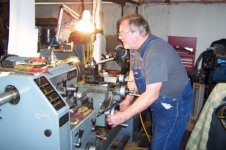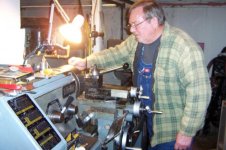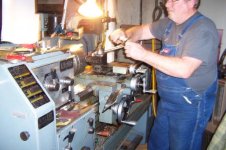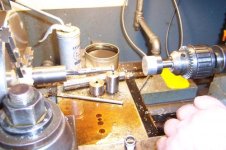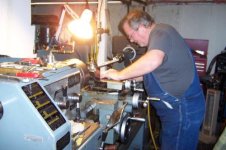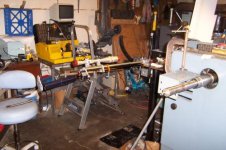H
huntinco
Guest
Ok, because I never met him in person or anyone that was there to actually watch his chambering method, this is how I’m guessing he did it. As you can see, his Victor lathe, that I now own, is long through the headstock, but has a large enough ID to accommodate any bore.

So here is what I gather in a nut shell.

First, he machined a bushing that fits snug inside the headstock spindle bore. Then one end of the bushing is machined a little undersized to allow for adjustment/ movement inside the spindle bore

He then machined a long tube that also fits snug inside the ID of the bushing and long enough to fit through the spindle.

This tube also has a hollow center on the pointed end that fits into the crown end of the barrel. On that back end of this tube there is a fitting to accommodate air or coolant into the barrel to clean out the chamber while it is being reamed.



At the back end of the spindle bore he machined a long spider for the tube to fit in that would allow for adjustment, by applying torque to this end it was transferred along the tube that was centered in the spindle bore by the bushing, where the pointed end would fit snug into the barrel and make it possible to adjust the crown end while it was inside the spindle bore.
I’m also assuming the reason for this set up was to align the chamber end to be reamed using the Gordy method and still be able to indicate the crown end while it is inside a spindle.



As far as the spider that he made attached to a bearing I have no idea what he used this for.

I have yet to chamber a barrel with this lathe because I want everything just right. So far I built a 60X100 shop around the lathe, made a few bushings for the tractor, and accurized 2 actions. What a waste!!! Its time to make a rifle or two,
Feedback please!!!!!
Maybe Butch can help us out on this one.
So here is what I gather in a nut shell.
First, he machined a bushing that fits snug inside the headstock spindle bore. Then one end of the bushing is machined a little undersized to allow for adjustment/ movement inside the spindle bore
He then machined a long tube that also fits snug inside the ID of the bushing and long enough to fit through the spindle.
This tube also has a hollow center on the pointed end that fits into the crown end of the barrel. On that back end of this tube there is a fitting to accommodate air or coolant into the barrel to clean out the chamber while it is being reamed.
At the back end of the spindle bore he machined a long spider for the tube to fit in that would allow for adjustment, by applying torque to this end it was transferred along the tube that was centered in the spindle bore by the bushing, where the pointed end would fit snug into the barrel and make it possible to adjust the crown end while it was inside the spindle bore.
I’m also assuming the reason for this set up was to align the chamber end to be reamed using the Gordy method and still be able to indicate the crown end while it is inside a spindle.
As far as the spider that he made attached to a bearing I have no idea what he used this for.
I have yet to chamber a barrel with this lathe because I want everything just right. So far I built a 60X100 shop around the lathe, made a few bushings for the tractor, and accurized 2 actions. What a waste!!! Its time to make a rifle or two,
Feedback please!!!!!
Maybe Butch can help us out on this one.
Last edited by a moderator:


